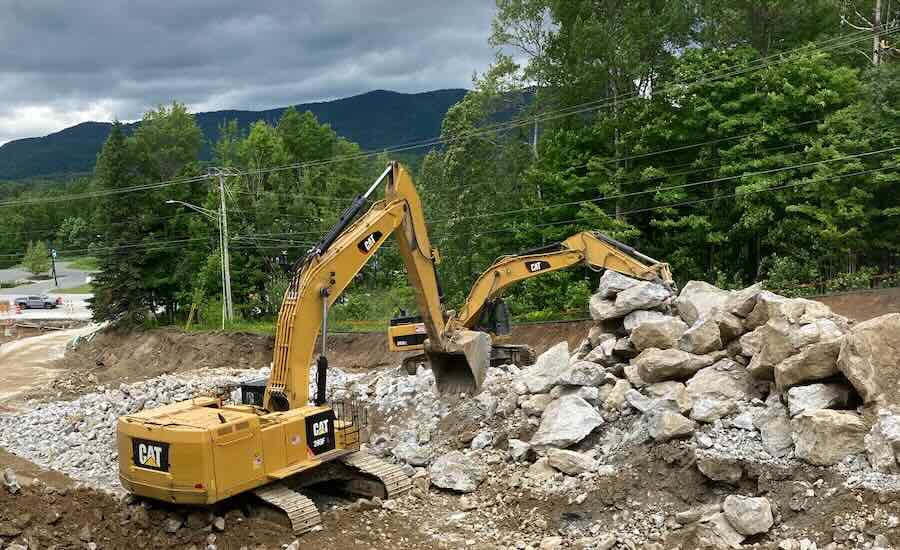Uncategorized
Infrastructure Work Kicks Off $5B Vermont All-Season Resort Expansion
p.p1 {margin: 0.0px 0.0px 0.0px 0.0px; font: 13.0px ‘Helvetica Neue’}
Markowski Contracting conducted mass excavation and rock removal before reconstruction of 1,300 linear ft of new road could begin.Photo courtesy of Markowski Excavating
A new pumphouse will pump water 1,425 ft. up the mountain to two planned storage tanks before gravity feeding it back down to the village, says Jeffrey Chase, project manager for Winchester, N.H.-based Casella Construction, contractor for the water line. “Four 400-horsepower pumps will pump under 625 lb of pressure,” he says.
Municipal water line work began in December 2023 and is set for completion by October, Chase says. In late May, the town hired S.U.R. Construction to the deliver the distribution lines, Sherman says.
Road work to construct 1,300 linear ft of new road began last April with a construction shut down in winter. Crews encountered more rock ledge than expected during excavation, which took longer to remove, says Mike Falk, surveyor and foreman for Markowski Excavating contractor for phase one road work.
He added that Capital Rock, a New Boston, N.H.-based drilling and blasting contractor, conducted blasting, leaving 40,000 yds of loose material and rock “that we removed to achieve the design’s road grade.”
Once crews remove the last communication line, the team will have two weeks left for final grading and ditch work, he says. Final touch-up is expected in June.
Phase two road work, expected to begin next spring, will complete a bike path, bus turn off, multiuse path, lighting and curbing, Sherman says.
Big Puzzle
The ski village’s base area will be completely reconstructed during phase one, including many grade changes. The new proposed road at its deepest will be about 16 ft below the existing grade. As the road is built, parking and phased removal of existing lodges to build the new lodge will require much coordination, since the resort will remain open.
“The challenge is to blend the estimated 2,200 ft of elevation required at the snow front and allow skier circulation to ski lifts while also achieving the required road grades for cars and creating level slopes into the pedestrian-friendly village,” says Peter Smiar, Vermont director of land development for VHB, the project’s civil engineer.
The VHB team also must construct a ski trail crossing of Killington Road that provides appropriate road grades while also allowing ski grade trails to have the required slopes.
“It’s a big puzzle to solve,” Smiar says, “which is fun from an engineering and planning perspective. We need to accommodate cars, bikes, skiers, pedestrians and shuttles—all while thinking about natural resource protection and permitting.”
The ski resort was originally designed to be constructed by the developer, but in 2022, the town assumed design and construction of the new water system and roadway through the village, Smiar says. Managing the project split between the town and the resort took a lot of communication with permittees and state agencies, but “ultimately it has had a positive impact on phasing since the town was able to move ahead with the road [construction] while Great Gulf finalizes their first phase of design,” Smiar says. “But facilitating the town and the developer on two different schedules requires extra coordination,” he adds.
The infrastructure work will be supported with nearly $90 million in funding, including state Tax Increment Financing (TIF), a $2.3-million American Rescue Plan (ARPA) grant, a $3-million Northern Border Regional Commission Catalyst grant, an $18.4-million U.S Dept. of Agriculture loan, a $2.5-million Vermont Bond Bank loan and a $25-million Rebuilding American Infrastructure with Sustainability and Equity (RAISE) grant from the U.S. Dept. of Transportation for road infrastructure improvements and stormwater processing upgrades, Sherman says.
Many of the municipal water-related loans will be forgiven because many of the water systems are contaminated by PFOAs (Perflurooctanoic Acid), a carcinogenic forever chemical, Sherman says. “The project will help resolve those issues,” she adds.
Permitting
Beyond the land acquisition, Sneyd says Great Gulf is committed to including investments in design, planning, permitting and site logistics. Since buying the land for $43 million in 2023, “we inherited an approved master plan for the preliminary project phase, Sneyd says. “We are now moving forward with amending those approvals to reflect Great Gulf’s updated vision for what will become the new phase one,” he adds.
Smiar adds that permitting is progressing positively with few natural resource concerns in the resort’s existing base area. “Overall, the town has been supportive,” he says.
With construction underway, Great Gulf is prioritizing sourcing materials from within the U.S., when possible, Sneyd says. But when the team was unable to find suitable American-made pipes for the ultra-high-pressure water line, “we got a waiver from Washington, D.C., for pipe coming from Austria,” Chase says. “It’s one of the first applications for use with such high pressure,” he says.
“At this stage, we’re planning for a range of scenarios and remain focused on delivering a best-in-class, four-season resort community with a thoughtful and resilient approach,” Sneyd says.


